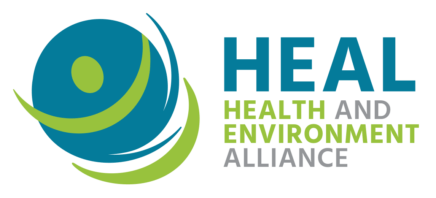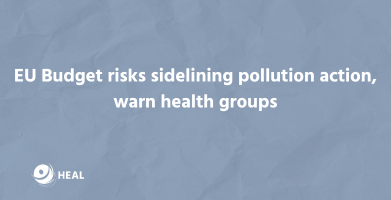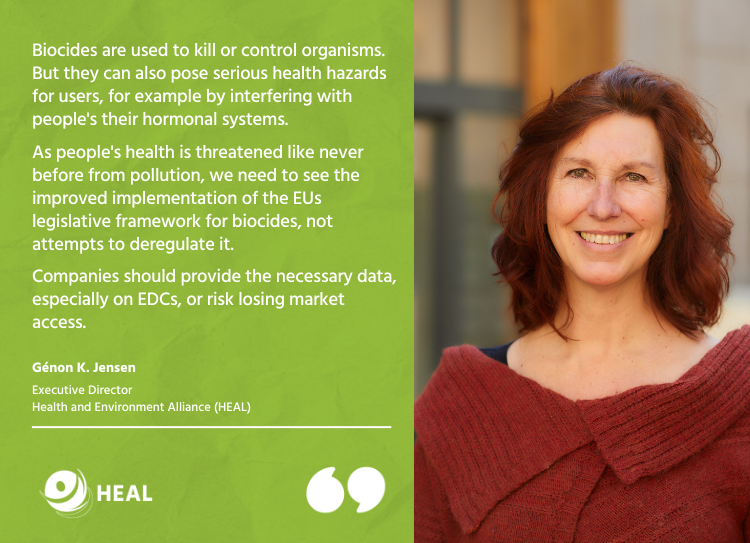PFHpA, a member of the hazardous PFAS family, is increasingly being found in our bodies and the environment. But not unlike in a mystery novel, this is happening without this substance even being registered in the EU for production or import. HEAL supports the Dutch proposal to identify PFHpA as a substance of very high concern under REACH, which would constitute the first step to put an end to our exposure to this toxic chemical. However, all PFAS need to be regulated as a group to truly get at the root of the problem to prevent further harm.
Perfluoroheptanoic acid (PFHpA) and its salts is just one of thousands of PFAS chemicals – a group of health-harming substances known as “forever chemicals” due to their extreme persistence or inability to break down in the environment. PFHpA is a prime example of why REACH must regulate the entire group of per- and polyfluoroalkyl substances (PFAS) in one go and phase out all non-essential uses as promised under the EU Green Deal’s Chemical Strategy for Sustainability.
PFHpA: a mysterious member of the PFAS family
There is clear and unequivocal scientific evidence that demonstrates global PFAS contamination in people and the environment. It’s also one of the most persistent human-made chemical groups known to date.
Older, long-chain PFAS, namely PFOA and PFOS, are known as legacy PFAS and have been banned and phased out of production due to their adverse impacts. However, industry continues replacing these legacy PFAS with short-chain counterparts like PFHpA under the false assertion that they are safe and sustainable. In reality, emerging research conducted by both independent and industry scientists on many of these short-chain PFAS demonstrates similar adverse effects to the legacy PFAS. In some instances, short-chain PFAS are proving even harder to remove from water [1] [2].
PFHpA is a minor degradation product of many different long-chain PFAS [3]. It has been found in waterways, rain, air, soil, wildlife, and humans in all corners of the world including in Europe. This is a real cause for concern, because PFHpA is not even registered and commercially produced in the EU. However, other PFAS are produced and imported into the EU, thus contributing to potential degradation that leads to PFHpA contamination.
PFHpA also falls into the same subgroup of similar, shorter-chain PFAS known as PFCAs, several of which were already identified under REACH as a substance of very high concern and are on the candidate list for authorisation [4].
Where PFAS (and the mysterious PFHpA) are found
PFAS are used in a whole slew of consumer and industrial products and applications, contributing to PFHpA’s growing ubiquity as a breakdown product derived from many of these sources. One of the main industrial uses of PFAS is in fire fighting foams. PFAS are known for their water- and stain-resistant properties and are also used in many different consumer products, including but not limited to [5] [6]:
- Fabrics and carpet
- Non-stick cookware
- Cleaning products
- Personal care products (e.g. cosmetics, dental floss, feminine hygiene products, etc)
- Food packaging
- Apparel
- Textiles
- Leather products
- Ski waxes
- Synthetic turf
Other examples of industries that rely heavily on PFAS include aerospace, defence, automotive, and aviation.
The different ways people are exposed to PFHpA
People are exposed to PFHpA through drinking water, air, food, breastmilk, and products used on a daily basis [7]. Avoiding exposure through these various routes is very difficult, if not impossible, as it is ubiquitous in our environment.
Like many other shorter chain PFAS, removing PFHpA from drinking water is tricky – conventional and advanced water treatment processes have proven insufficient at filtering it out. As a result, it has increasingly been detected in bottled, tap, and ground and well water [8]. It has also been detected in food, migrating from many different potential sources such as food packaging, non-stick cookware, consumer products, and uptake throughout the food chain [9].
Scientists have also found several PFAS that are potential precursors of short-chained breakdown products such as PFHpA, PFHxA, PFPeA, and PFBA in vulnerable populations, including pregnant women and children living in six EU countries with higher fish consumption [10]. This research demonstrates increased risk of adverse long-term effects of PFAS exposure on highly vulnerable populations, in addition to potential irreversible impacts on future generations’ health and well-being [11].
PFHpA affects our health
PFHpA affects many organs in the body. It’s been found to last for a long time and bioaccumulate in our bodies. Scientists have raised concerns over both combined exposures to chemical mixtures that include PFHpA, in addition to cumulative exposure over time to these chemical mixtures. Low-dose effects associated with PFAS exposure in humans have also been observed. Thus, a safe dose cannot be determined [12].
Adverse health impacts linked directly to exposure to PFHpA include [13]:
- Reprotoxicity: In 2020, the European Chemicals Agency’s (ECHA) Committee for Risk Assessment (RAC) concluded that PFHpA may damage the foetus causing such reproductive and developmental effects as preeclampsia, lower birth weight, delayed mammary gland development, early puberty onset, low sperm count and mobility, and increased miscarriage [14] [15].
- Liver damage: In 2020, ECHA’s Committee for Risk Assessment (RAC) also concluded that PFHpA has specific toxic effects on the liver after repeated exposure [16].
- Endocrine disruption: Animal studies provide evidence of interference of PFHpA with thyroid hormones, potentially contributing to thyroid disease [17].
- Kidney damage: Human studies have linked exposure to PFAS including PFHpA and increased odds of kidney disease [18].
Adverse health impacts linked more generally to PFAS: [19] [20]
- Obesity, diabetes, and high cholesterol: The scientific literature suggests that general PFAS exposure is linked to increased risk of metabolic disorders and human insulin resistance [21].
- Cancer: Scientific reviews of the literature have found increased risk of testicular and kidney cancers from exposure to PFAS [22] [23].
- Effects on the immune system: Scientific research suggests that PFAS exposure is associated with such adverse effects as reduced vaccine antibodies in children, immunosuppression, asthma, and allergies [24] [25].
PFHpA’s widespread environmental impact
PFHpA’s intrinsic properties and extreme mobility in water allow it to persist and move long distances in aquatic environments, far from sources of emissions. It has been detected in the Arctic and Antarctic, contaminating remote fragile ecosystems globally [26]. PFHpA has also been detected in endangered species including arctic foxes and polar bears, which are thought to be exposed through their diet of fish. It is also known to bioaccumulate in birds and mammals, potentially impacting wildlife and humans long term [27]. PFHpA far exceeds the established threshold for a very persistent, mobile chemical with its high potential to irreversibly impact the environment and human health.
PFHpA: an example of why all PFAS chemicals need to be regulated as a group
Existing evidence is more than sufficient to justify PFHpA’s identification as a substance of very high concern, just as other closely related short-chain PFAS have been. The scientific literature on PFHpA is comprehensive and clear, composed of many standard tests, monitoring and modelling studies, grouping and read-across approaches based on its analogues, and (Q)SAR results [28]. This is why we support the Dutch’s proposal to identify PFHpA as a substance of very high concern and place it on REACH’s black list of chemicals.
PFHpA is a poster child for why PFAS chemicals must also be regulated as an entire group to avoid regrettable substitution and prevent further irreversible damage to the environment and human health. HEAL calls upon the ECHA Member States Committee to support this proposal when it meets to discuss it this week, 12 December 2022, and urges the EU Commission to keep its commitment under the EU Chemicals Strategy [29].




